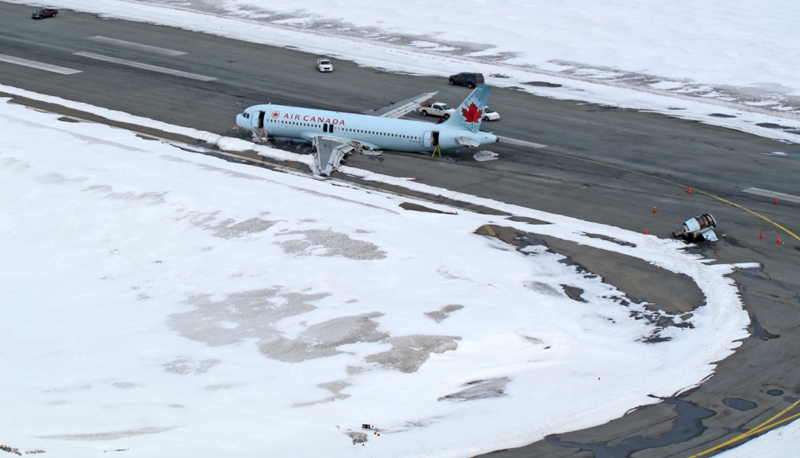WATCH: An Air Canada flight from Toronto crash landed on a snowy night in Halifax, with 138 people on board. As Ross Lord reports, investigators are now poring over the wreckage.
HALIFAX – Accident investigators continued to search Monday for the cause of Sunday’s Air Canada flight 624 crash that sent 25 people to hospital.

Transportation Safety Board investigators arrived at Halifax Stanfield International Airport in Enfield, N.S. on Monday along with investigators from the airport, Air Canada, plane manufacturer Airbus and federal regulators Nav Canada and Transport Canada.
Mike Cunningham, TSB regional manager of air investigations, said the investigation is going well so far and everybody has been co-operative. He said a key point will be determining why the airplane was so low on approach.
“The big thing is the teams out on the runway to continue to document the accident site, going right back to the initial impact position and identifying all the major components of wreckage we have between that position and where the aircraft wound up,”Cunningham said at the airport Monday.
WATCH: Investigation gets underway at site of Halifax plane crash. Marieke Walsh reports.
On Sunday at 12:40 a.m. the landing gear of the A320 Airbus hit the bright-orange antenna array – part of the airport’s instrument landing system – 335 metres short of the runway as it landed. A wing was damaged and one engine was torn off the plane when its underbelly of the plane hit the asphalt runway.
The plane, which was carrying 133 passengers and five crew members, skidded for another 335 metres before coming to a stop.
Twenty-five people were taken to hospital where they were treated for mostly minor injuries.
Cunningham said the TSB will “document everything and photograph everything” as part of its investigation.
Investigators will also try to determine whether the snowstorm that caused the flight to circle the airport for nearly a half hour before landing had any effect.
READ MORE: A look at Air Canada’s safety record
“We’ll look at everything. We won’t leave any stone unturned,” Cunningham said. “We’ll look at the weather, we’ll look at the operation of the aircraft, we’ll look at the whole thing.”
In a statement issued Monday, the TSB said the plane became airborne again after it initially touching down, leaving an extensive debris field between the localizer antenna and the beginning of the runway.
“The initial impact was significant and caused substantial damage to the aircraft,” the statement said. “During this impact, the aircraft collided with a localizer antenna array – part of the instrument landing system – and became airborne again, travelling forward on Runway 05.”
The board said the next steps of the investigation will include; continuing to examine and photograph the wreckage, removing the aircraft from the runway, gather Air Traffic Control voice and data recordings, conduct witness interviews and gather weather information from the day of the crash.
Klaus Goersch, the chief operating officer of Air Canada, insisted Sunday that the weather was good enough to land, saying it was “safe to fly in this weather.”
The plane’s cockpit voice recorder has been sent to Ottawa for analysis.
Cunningham said at a press conference Sunday evening that everyone on board the flight was fortunate to have survived.
“I’d say they’re pretty lucky,” he said.
Airport officials said Monday things are operating “as close to normal as can be expected.”
The airport is conducting its own investigation into its response to Sunday’s events, including why it took nearly an hour to get passengers from the plane back to the terminal.
“We do believe we can do it better, we do believe we can do it faster and we believe it’s one of the key focuses in our review,” said Peter Spurway, vice-president of corporate communications for the airport.
With files from Natasha Pace, Andrew Russell and The Canadian Press






Comments